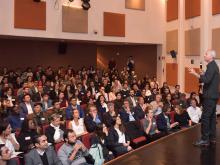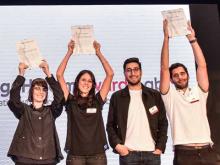A meeting on the MIT campus has laid the foundation for better coordination of global research relating to cement and sustainability.
Leaders of cement and concrete industry organizations from 11 countries and regions from around the US met with researchers from the MIT Concrete Sustainability Hub (CSHub) in February to discuss cement and sustainability research and collaborate on opportunities to advance further research.
“Concrete plays a fundamental role in shaping modern life. Thanks to scientific and technological breakthroughs, it also is part of the solution when it comes to planning for more sustainable development,” said Jeremy Gregory, CSHub executive director and research scientist in the MIT Department of Civil and Environmental Engineering.
"Events like this meeting ensure in the important research in this arena has the largest possible impact.”
Since its founding in 2009, the CSHub has been a leader in research designed to reduce the environmental impact of concrete both in its manufacturing and its use. Such work is vitally important because there is no other material on the planet that can replace concrete when it comes to meeting demands of our civilization for housing, business, transportation and infrastructure.
Work by the CSHub has always been collaborative — the CSHub itself is an interdisciplinary team of researchers from multiple departments across MIT, and the team’s work regularly brings together leaders from academia, industry, and government. The meeting gave the industry leaders an opportunity to present information about sustainability trends in their regions and countries, to learn about current work at the CSHub, and to see where there might be opportunities for cooperation.
Among the current projects discussed with attendees was one in which the CSHub has teamed up with researchers at Oregon State University (OSU) and the University of New Brunswick (UNB), Canada, to gain scientific understanding to improve the durability of concrete, including potential means to mitigate freeze-thaw and alkali-silica reaction (ASR).
MIT is providing atomic and meso-scale modeling expertise and applications for the durability project, while OSU and UNB are contributing micro- and material macro-scale empirical expertise.
Gregory told the meeting attendees, “The interesting thing about the collaboration with OSU and UNB is that it was facilitated by our industry partners. Our partners knew that we had certain pieces to this puzzle and that the researchers at these other schools had some important pieces as well.”
The Portland Cement Association convened the global meeting, and along with the Ready Mixed Concrete Research and Education Foundation, provides funding to the CSHub. With attendees hailing from Belgium, Columbia, Germany, Switzerland, the Netherlands, Australia, South Africa, China, India, and Canada, along with U.S. regions, the meeting represented a widening of the circle of leaders worldwide who can contribute to future research breakthroughs.
“We see the MIT CSHub as a hub of knowledge — a forum where the brightest minds from the academic world and private industry can connect to plan and conduct important industry research,” said James G. Toscas, PCA President and CEO. “This meeting was about inviting ideas and creating new connections on the international scale.”
PCA is the primary policy, research, education, and market intelligence organization serving America’s cement manufacturers. PCA members represent 93 percent of U.S. cement production capacity and have facilities in all 50 states. The association promotes safety, sustainability, and innovation in all aspects of construction, fosters continuous improvement in cement manufacturing and distribution, and generally promotes economic growth and sound infrastructure investment.
“As vocal advocates for sustainability, cement manufacturers are acutely aware of the role that concrete has had — and will continue to have — in building a resilient, sustainable world,” said Toscas. “We believe that the connections made during this meeting will result in research partnerships and revolutionary ideas that lead to even more durable and sustainable homes, buildings, and infrastructure across the globe.”





